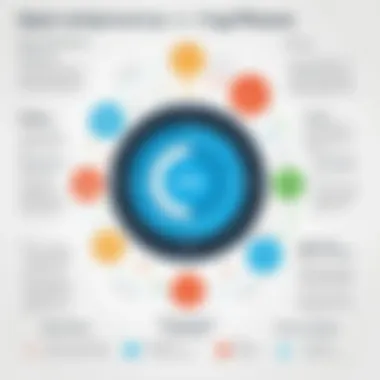Understanding Open Source Marketing Automation Tools


Intro
Open source marketing automation has become a critical topic for organizations seeking innovative ways to enhance their marketing strategies. It combines the principles of accessibility and customization with the robust functionalities typical of marketing software. As businesses look to improve efficiency and save costs, understanding this market segment is vital. This section aims to provide insights into the essential aspects of open source marketing automation, enabling various stakeholders to make informed decisions.
Overview of Software
Purpose and Use Cases
Open source marketing automation software serves multiple purposes. Primarily, it allows businesses to streamline marketing processes, from email campaigns to social media management. The software can handle tasks like lead generation, customer segmentation, and performance analytics. It is particularly beneficial for small to medium-sized enterprises (SMEs) looking to adopt marketing automation without the heavy financial burdens associated with proprietary solutions. Additionally, organizations may use it for:
- Building customer relationships through personalized communication
- Improving ROI via insightful data analytics
- Integrating various marketing channels for cohesive strategy execution
Key Features
Key features of open source marketing automation tools include:
- Flexibility: Users can modify the software according to their specific needs.
- Cost-Effectiveness: Many options do not have licensing fees, reducing overheads.
- Community Support: An active community is often available to provide assistance and share enhancements.
- Data Control: Businesses maintain their data, reducing risks related to privacy.
In-Depth Review
Performance Analysis
When evaluating open source marketing automation software, performance is essential. Speed and reliability can differ based on the hosting environment and software architecture. Tools like Mautic have robust capabilities that can handle high volumes of emails and complex data sets. Performance can also vary based on integration capabilities with other tools. Therefore, conducting performance tests and ensuring compatibility with existing systems become necessary to ensure a seamless user experience.
User Interface and Experience
The interface and overall user experience can greatly influence the effectiveness of open source marketing automation. A well-designed interface facilitates easier navigation and quicker task execution. Tools such as SuiteCRM have gained popularity due to their intuitive user interfaces. However, some open source solutions may require a steeper learning curve. Therefore, determining how user-friendly the software is before implementation helps in future adoption and efficiency.
"Choosing the right open source marketing automation tool can substantially affect your marketing outcomes. Analysis of both features and user experience should guide your choice."
Foreword to Open Source Marketing Automation
Defining Open Source Marketing Automation
Open source marketing automation refers to software systems that allow users to automate marketing tasks while providing access to their source code. This means users can modify, improve, and share the software based on their needs. These tools typically enable marketing teams to perform various functions, such as managing email campaigns, tracking customer interactions, and analyzing performance metrics in real-time. The collaborative nature of open-source allows for constant evolution and adaptation to market demands.
Key Features of Open Source Marketing Automation
- Customization: Users can tweak features and functions to fit their specific needs.
- Cost: Typically more affordable than proprietary counterparts, reducing financial burden.
- Community Support: Users benefit from forums and discussions, fostering knowledge sharing.
- Transparency: Users can inspect the codebase for security and functionality purposes.
The Evolution of Marketing Automation
Marketing automation has come a long way from its early days when email tools reigned. In the past, many businesses relied on basic email marketing tools and manual processes. Over time, these solutions evolved into robust systems integrating various marketing channels under a single umbrella. Open source marketing automation has emerged as a response to both the limitations of traditional software and the growing demand for flexible solutions.
Adoption of this technology is surging as businesses recognize the value of data-driven marketing strategies. Companies are increasingly interested in tools that allow for agility and adaptability in their campaigns without the restrictions that come with proprietary systems. Understanding the transition towards open source not only clarifies its current landscape but also highlights the trends influencing its future development.
"The shift to open source marketing automation signifies a larger trend in business, prioritizing flexibility and community over Closed proprietary systems."
With the widespread adoption of platforms like Mautic and Odoo, the evolution of open source marketing automation will likely continue, shaping how organizations connect with their audiences in a more data-informed manner.
Benefits of Open Source Solutions
Open source marketing automation offers numerous benefits that attract businesses and marketers alike. These advantages stem from the fundamental philosophy of open source software, which centers on freedom, collaboration, and innovation. Understanding these benefits helps in making informed decisions about marketing strategies and tool selection, fostering a deeper connection with potential customers through more effective marketing efforts.
Cost Efficiency
Cost efficiency stands out as a primary reason organizations opt for open source marketing automation tools. Traditional marketing software can be quite expensive, often charging hefty subscription fees. In contrast, open source solutions typically have lower upfront costs. Many of these tools are free to use, which can significantly reduce initial expenditure for startups and small businesses.
Moreover, even when there are costs involved, such as hosting or support, these tend to be more predictable. You maintain the ability to pay only for necessary additional features or services, in essence customizing your spend according to specific needs. This flexibility can be especially beneficial to non-profit organizations, which often operate on limited budgets.
Customization and Flexibility
Customization is another key advantage of open source marketing tools. Most proprietary systems offer a somewhat rigid framework that limits user adaptation. On the other hand, open source platforms, such as Mautic or Odoo, allow users to customize software according to their unique business requirements. This flexibility can significantly enhance overall performance and user satisfaction.
Users can tweak various features, from user interfaces to workflows, aligning tools closely with their marketing strategies. Additionally, developers can contribute to the ongoing improvement of these solutions, establishing a system that continuously evolves with market trends and user feedback. Such proactive enhancements can lead to optimized marketing campaigns and better engagement with audiences.


Community Support and Collaboration
Open source projects often foster a strong sense of community. When businesses adopt open source marketing automation tools, they benefit not just from the software itself, but also from a network of users and developers. This community plays a critical role in troubleshooting problems and sharing best practices.
The collaborative nature of open source leads to enhanced documentation and resources, improving usability over time. Organizations can seek help from forums, such as reddit.com, or local user groups. This communal spirit also sparks innovation as users share modifications or plugins designed to enhance the base tools, thereby contributing to continuous improvement.
"Community collaboration drives the progression of open source tools, ensuring they remain relevant and effective."
The synergy among developers and users leads to a robust ecosystem, where information and support flow freely. This environment accelerates learning and promotes best practices in marketing automation, putting organizations in a powerful position to elevate their marketing endeavors.
Challenges Associated with Open Source Marketing Automation
The exploration of open source marketing automation indicates a landscape ripe with possibilities yet fraught with challenges. Understanding these challenges is pivotal. These obstacles can influence the effectiveness of marketing strategies and the overall adoption of such tools within organizations.
Technical Complexity
Navigating the technical complexities of open source marketing automation can be daunting. While these tools often offer a wealth of features, integrating them with existing systems may require advanced technical skills. Unlike proprietary solutions that come with extensive support, open source platforms frequently lack comprehensive guides or user-friendly interfaces. Users must often rely on community forums or third-party experts to troubleshoot issues or implement custom features.
The necessity for skilled developers can make the initial setup time-consuming and costly. For small businesses or teams with limited technical expertise, this might pose a significant barrier. Additionally, as technology evolves, maintaining and updating these tools requires ongoing technical knowledge.
Documentation and Usability Issues
A notable challenge with many open source marketing automation tools is the inconsistency in documentation. In many cases, the available documentation may be insufficient or outdated. This can lead to confusion, especially for users who are less familiar with the platform or its capabilities.
Usability can also vary widely across different tools. Some platforms boast intuitive user interfaces, while others present steeper learning curves. A tool that lacks an intuitive design can discourage users from fully utilizing its capabilities. Additionally, community-driven projects may have scattered resources, making it difficult for users to find consolidated help or guidance.
Security Concerns
Security is a paramount consideration when employing open source marketing automation tools. While open source software can provide transparency and enhanced security through community scrutiny, it also poses unique risks. The public nature of source code might attract malicious actors who seek to exploit vulnerabilities. Furthermore, the responsibility to implement security measures falls on the user or the team managing the software, rather than the vendor.
Organizations must prioritize consistent updates and patches. However, in practice, not all teams have adequate resources to manage these ongoing security needs. Smaller businesses may not possess the capacity to monitor and mitigate potential threats effectively, putting sensitive data at risk.
"Security management requires vigilance; ignoring it can lead to significant repercussions."
In summary, while open source marketing automation offers significant benefits, the associated challenges must be addressed diligently. A thorough understanding of technical complexity, documentation and usability issues, and security concerns is essential for effective implementation. Every organization must weigh these factors against the potential advantages to make informed decisions.
Comparison with Proprietary Marketing Automation Software
When considering marketing automation solutions, the distinction between open source and proprietary software becomes crucial. Each category offers distinct advantages and disadvantages that may influence a business's choice of a strategy. This section explores the notable factors of cost considerations, feature sets, limitations, and vendor lock-in risks associated with proprietary systems.
Cost Considerations
Open source marketing automation tools typically offer a more affordable option compared to proprietary software. The licenses for proprietary systems can be quite costly, often requiring ongoing subscription fees. In contrast, tools like Mautic or Odoo primarily involve initial setup costs and may allow users to bypass recurring fees. While open source tools might need investments in hosting or development, they often lead to a lower total cost of ownership over time.
Some key points about cost considerations include:
- Initial licensing fees for proprietary solutions tend to be high.
- Open source tools may involve variable costs related to setup and maintenance.
- The long-term savings of using an open source model can be significant.
"Choosing the right marketing automation tool can significantly impact overall marketing budgets and ROI."
Feature Set and Limitations
The feature sets of open source solutions can compete with proprietary systems well. Tools like Mautic offer robust functionality, allowing for email marketing, lead generation, and analytics. However, proprietary software such as HubSpot or Salesforce may have a more polished interface or advanced features. Additionally, the speed of updates and the inclusion of customer support varies dramatically. Open source tools often rely on community support and documentation, which may be less cohesive than the dedicated support offered by proprietary vendors.
Considerations include:
- Open source systems may lag behind proprietary solutions in terms of user interface and design.
- Community-driven updates can lead to variability in feature availability.
- Proprietary tools often provide comprehensive support, streamlining the user experience.
Vendor Lock-in Risks
One of the notable risks of proprietary systems is vendor lock-in. Businesses often find it challenging and costly to migrate away from established proprietary platforms. Since open source tools allow more flexibility, switching between different solutions becomes easier, reducing the risks associated with vendor dependencies. This ability to adapt is particularly valuable for organizations that foresee changing needs over time.
Key aspects related to vendor lock-in include:
- Proprietary software may tie businesses into their ecosystems, making it cumbersome to switch.
- Open source solutions facilitate easier transitions and integrations with other systems.
- The flexibility of open source prevents potential future challenges associated with vendor policies.


In summary, the comparison between open source and proprietary marketing automation software reveals key insights. While cost considerations favor open source options, features and vendor support differ significantly. Understanding these elements allows businesses to make informed choices based on their needs.
Key Open Source Marketing Automation Tools
Understanding the key open source marketing automation tools is crucial for any organization looking to enhance its marketing strategy while minimizing cost. These tools provide powerful functionalities that can compete with proprietary solutions, allowing users to tailor their automation processes to their unique needs. In this section, we will examine three prominent tools: Mautic, Odoo, and EspoCRM. By delving into their features, benefits, and considerations, we aim to equip readers with the knowledge to select the best option for their needs.
Mautic
Mautic stands out as a leading open source marketing automation tool. It offers a comprehensive suite of features designed to assist marketers in engaging their audience effectively. One of the significant advantages of Mautic is its ability to integrate with a variety of platforms. This feature enables seamless management of campaigns across multiple channels, including email, social media, and websites.
Mautic provides tracking capabilities that allow marketers to monitor user interactions. This data facilitates personalized marketing campaigns, enhancing the customer journey. Moreover, its user-friendly interface makes it accessible for those who may not have extensive technical knowledge.
In terms of community support, Mautic benefits from an active user base. This community contributes by sharing plugins and providing troubleshooting assistance, enriching the overall user experience. The flexibility to modify the platform according to specific business needs further solidifies its position as a top choice for open source marketing automation.
Odoo
Odoo presents a robust solution, known for its integrated business management capabilities. While primarily recognized for its enterprise resource planning (ERP) features, Odoo includes a marketing automation module that can streamline various marketing functions. It supports functionalities like email campaigns, lead generation, and event management.
One of the notable aspects of Odoo is its modular approach. Users can choose from a wide range of applications, allowing them to tailor the software to fit their operational requirements. This adaptability is a significant selling point because businesses can scale their marketing efforts as they grow.
Another advantage is the intuitive interface, which can reduce the learning curve for new users. Furthermore, Odoo's comprehensive reporting tools help businesses analyze their marketing performance, providing valuable insights that can guide future strategies.
EspoCRM
EspoCRM is another noteworthy tool in the realm of open source marketing automation. While primarily a customer relationship management system, it offers essential marketing automation features that can significantly benefit small to medium-sized businesses. EspoCRM allows users to manage contacts, track interactions, and automate marketing engagements seamlessly.
This software places a strong emphasis on user experience. The clean and organized interface ensures users can navigate effortlessly, making it simpler to manage marketing tasks. Its custom field and entity options enable businesses to adapt the system to their specific requirements, whether for lead management or sales forecasting.
Additionally, EspoCRM provides integration capabilities with other platforms, enhancing its usability across various marketing activities. This characteristic allows businesses to maintain a cohesive approach to their marketing initiatives.
In summation, selecting the right open source marketing automation tool depends on the specific needs of the business. Each tool, whether it be Mautic, Odoo, or EspoCRM, offers unique features and benefits suited to different operational contexts. Understanding these key tools enhances the potential for effective marketing strategies.
Integration with Existing Systems
Integration with existing systems is a crucial aspect of implementing open source marketing automation. Businesses often operate multiple software solutions that address different needs. An effective marketing automation tool must seamlessly connect with these systems to ensure smooth operations. This integration allows companies to maintain consistency in their data and processes.
When evaluating open source marketing automation solutions, it is essential to consider how well they can interface with existing tools. The ideal situation avoids silos of data. Instead, it promotes a harmonious workflow across different software. Integrating various systems can lead to significant advantages such as improved efficiency and data accuracy. It can also enable real-time decision-making through thorough data analysis.
API Utilization
Application Programming Interfaces (APIs) play a vital role in the integration process. Many open source marketing automation platforms provide APIs that allow other software applications to communicate effectively. These APIs can facilitate tasks like data transfer, triggering automated actions, and syncing customer data across systems.
The benefits of utilizing APIs in marketing automation include:
- Streamlined Processes: APIs can automate repetitive tasks, freeing up valuable resources within teams.
- Enhanced Data Management: They allow for easier access to customer data, enabling personalized marketing strategies.
- Interoperability: APIs help different tools work together, ensuring that teams can leverage existing investments in software.
"APIs serve as the bridges between various applications, allowing them to work together efficiently."
Integrating via APIs minimizes manual input, reducing the risk of errors. This ensures that the marketing team has access to the most current data, which is essential for timely and effective campaigns.
Data Migration Strategies
Data migration is another critical factor to consider when integrating open source marketing automation solutions. If organizations want to switch to a new system, they must have a strategy in place for transferring existing data. Poor data migration can lead to inaccuracies and lost opportunities.
Businesses should adopt the following strategies for effective data migration:
- Assessment: Before moving data, evaluate the current data structure. Identifying what needs to be migrated is essential.
- Mapping: Create a clear mapping document that indicates how data from the old system will fit into the new one. This ensures a smooth transition.
- Testing: Implement tests before the actual migration. This can help identify potential issues.
- Backup: Always back up data before starting the migration to prevent any loss.
- Monitoring: After migration, it’s crucial to monitor the system to ensure everything functions as expected.
With effective data migration strategies, organizations can preserve data integrity while integrating new marketing automation tools. This proactive approach helps prevent disruptions in marketing efforts during the transition.
Future Trends in Open Source Marketing Automation
The landscape of open source marketing automation is evolving rapidly. Understanding the future trends enhances the capacity for businesses to adapt and thrive. As technology continues to advance, open source marketing automation can leverage emerging capabilities and address current challenges effectively. Two prominent trends are particularly noteworthy: integration of Artificial Intelligence (AI) and Machine Learning (ML), and a heightened focus on data privacy and security. These trends not only signify a shift in how marketing is approached but also redefine the user experience significantly.
AI and Machine Learning Integration


The integration of AI and Machine Learning into open source marketing automation tools is becoming increasingly critical. These technologies allow businesses to automate complicated tasks, glean insights from vast amounts of data, and personalize customer interactions at scale. AI algorithms can analyze customer behavior patterns, helping to predict future engagements. This leads to more tailored marketing strategies, enhancing user experience and customer satisfaction.
Businesses that utilize AI and ML can uncover actionable insights that inform decision-making processes. For instance, tools that employ these technologies can deliver recommendations on content, timing, and channels for campaigns, facilitating improved engagement metrics. Moreover, automated responses powered by AI reduce workloads on marketing teams, optimizing operational efficiency. As the market for these technologies expands, open source solutions will likely become more accessible, enabling companies of all sizes to adopt innovative marketing strategies.
Increased Focus on Data Privacy and Security
With growing awareness of data privacy issues, the importance of security in marketing automation cannot be overstated. Regulatory frameworks like the General Data Protection Regulation (GDPR) put a spotlight on how organizations handle customer data. Open source marketing automation tools are increasingly focusing on offering robust security features that comply with these regulations.
This emphasis on security is not merely a response to regulatory demands— it is also about gaining consumer trust. Customers are more informed and cautious about how their data is used. Tools that prioritize data encryption, secure data storage, and transparent data usage policies foster trust and loyalty among users. Moreover, businesses need to actively communicate their privacy stance to customers, establishing themselves as responsible stewards of data.
"The evolution of technology demands that open source marketing tools adapt to remain competitive. Adaptation is not a choice; it is a necessity."
Case Studies: Successful Implementations
Understanding successful implementations of open source marketing automation tools can provide significant insights into how these solutions can be transformed into practical, real-world applications. By examining case studies, businesses and organizations can learn valuable lessons about leveraging open source tools to meet their specific needs. Case studies highlight not only the successes but also the challenges faced by users, making them instrumental in shaping future strategies.
Small Businesses Leveraging Open Source Tools
Small businesses often operate with limited budgets, making cost-effective solutions crucial. Open source marketing automation tools are an attractive option as they allow for significant savings without sacrificing functionality. For example, a small e-commerce store using Mautic can automate email campaigns, track visitor behavior, and segment their audience without paying high subscription fees associated with proprietary software.
The adoption of open source tools like Odoo allows small enterprises to integrate various marketing activities into one platform. This streamlining is vital for maximizing efficiency and minimizing overhead. Since many of these tools are highly customizable, small businesses can tailor their marketing automation to their specific requirements. The ability to evolve the software as the business grows further drives adoption.
Benefits of using open source tools include:
- Cost savings on licensing
- Increased flexibility for customization
- Community-driven support for troubleshooting
The challenges may involve technical complexities, but small businesses that invest time in proper implementation can reap long-term rewards.
Non-Profit Organizations Using Mautic
Non-profit organizations often face unique challenges in marketing, primarily due to budget constraints and the need to communicate effectively with stakeholders. Mautic, being an open source marketing automation platform, offers non-profits an excellent opportunity to enhance their outreach efforts without financial burden.
For instance, a non-profit focused on environmental conservation can use Mautic to design compelling email campaigns that raise awareness about their initiatives. Their ability to track engagement metrics allows them to refine their messaging dynamically, ensuring that their outreach remains relevant.
Moreover, non-profits can streamline their donation processes through effective audience segmentation and personalized communications. This capability is vital for fostering donor relationships and increasing funding for their missions.
Some advantages for non-profits using Mautic include:
- No licensing fees, enabling budget allocation for other essential services
- Simplified reporting on campaign performance
- Ability to engage with volunteers and stakeholders effectively
In summary, examining these case studies illuminates how open source marketing automation can bring about significant improvements in operational efficiency and outreach capabilities. The findings reveal a clear pattern: organizations of varying backgrounds benefit tremendously when they understand and implement the right open source tools tailored to their specific needs and goals.
Culmination and Recommendations
The section on conclusion and recommendations plays an essential role in any comprehensive article about open source marketing automation. It distills the key insights gathered throughout the exploration, allowing readers to walk away with actionable information. The importance of this section lies in the synthesis of prior content, providing a clear pathway for businesses and marketers who are contemplating the switch to open source solutions.
Mainly, it emphasizes the necessity for thorough evaluation of business needs. Companies vary in their requirements based on size, market niche, and existing technological infrastructure. Hence, having a clear understanding of specific needs can guide the selection of appropriate tools. This not only ensures that the company's marketing automation strategy is aligned with its overall goals but also maximizes the return on investment.
Additionally, the recommendations to choose the right tools are paramount. It is important to assess various open source options available and determine which ones best fit the outlined needs. Factors to consider include ease of use, scalability, community support, and features offered. Not every tool will meet every requirement, so a careful analysis will lead to more effective outcomes.
A strategic approach can save time and resources, making your marketing automation successful.
Assessing Business Needs
In the realm of open source marketing automation, assessing business needs serves as a critical first step. This involves a detailed examination of the current marketing approaches, followed by identifying gaps and desired outcomes. It's essential to recognize specific objectives. For instance, a small business may prioritize lead generation, while a larger enterprise might focus on advanced analytics.
Furthermore, involving stakeholders in this assessment is key. Engaging marketing teams and technical staff can provide diverse perspectives, leading to more holistic insights. Each department may have unique demands that deserve consideration. By compiling this information, a checklist can be created to rank the most pressing needs.
Some aspects to analyze include:
- Current pain points in marketing processes
- Desired functionalities (e.g., email automation, CRM integration)
- Budget constraints and expected ROI
- Long-term scalability considerations
Through this structured approach, businesses can ensure they are not merely reacting to trends but consciously tailoring their solutions to address real challenges.
Selecting the Right Tools for Your Approach
After the assessment is complete, selecting the right tools is the next logical step. The open source landscape is vast and varied, with multiple options available, which can be overwhelming for businesses. The strategy here needs to be systematic.
First, compiling a shortlist of potential tools based on the needs assessment is beneficial. Then, a deeper exploration of features becomes necessary. For instance, comparing technologies like Mautic, known for its comprehensive marketing capabilities, with Odoo, which offers integrated business management functions.
When considering tools, pay attention to:
- User interface and experience: A straightforward interface can speed up adoption rates.
- Community and support: Active communities often indicate strong support networks where issues can be addressed promptly.
- Documentation and resources: Well-documented tools can reduce onboarding time for new users.
- Customization options: The ability to adapt tools to specific needs without extensive coding is crucial.







